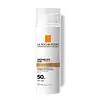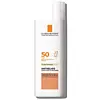What's inside
What's inside
 Key Ingredients
Key Ingredients

 Benefits
Benefits

 Concerns
Concerns

 Ingredients Side-by-side
Ingredients Side-by-side

Water
Skin ConditioningC12-15 Alkyl Benzoate
AntimicrobialGlycerin
HumectantOctocrylene
UV AbsorberNiacinamide
SmoothingButyl Methoxydibenzoylmethane
UV AbsorberDimethicone
EmollientEthylhexyl Triazone
UV AbsorberSilica
AbrasiveAluminum Starch Octenylsuccinate
AbsorbentVinyl Dimethicone/Methicone Silsesquioxane Crosspolymer
Terephthalylidene Dicamphor Sulfonic Acid
UV AbsorberPotassium Cetyl Phosphate
EmulsifyingDrometrizole Trisiloxane
UV AbsorberPEG-100 Stearate
Stearyl Alcohol
EmollientGlyceryl Stearate
EmollientAmmonium Polyacryloyldimethyl Taurate
Emulsion StabilisingBenzyl Alcohol
PerfumingBenzyl Benzoate
AntimicrobialCapryloyl Salicylic Acid
ExfoliatingCaprylyl Glycol
EmollientHydrolyzed Hyaluronic Acid
HumectantPhenoxyethanol
PreservativePhenylethyl Resorcinol
AntioxidantPoloxamer 338
EmulsifyingTocopherol
AntioxidantTriethanolamine
BufferingTrisodium Ethylenediamine Disuccinate
Xanthan Gum
EmulsifyingParfum
MaskingWater, C12-15 Alkyl Benzoate, Glycerin, Octocrylene, Niacinamide, Butyl Methoxydibenzoylmethane, Dimethicone, Ethylhexyl Triazone, Silica, Aluminum Starch Octenylsuccinate, Vinyl Dimethicone/Methicone Silsesquioxane Crosspolymer, Terephthalylidene Dicamphor Sulfonic Acid, Potassium Cetyl Phosphate, Drometrizole Trisiloxane, PEG-100 Stearate, Stearyl Alcohol, Glyceryl Stearate, Ammonium Polyacryloyldimethyl Taurate, Benzyl Alcohol, Benzyl Benzoate, Capryloyl Salicylic Acid, Caprylyl Glycol, Hydrolyzed Hyaluronic Acid, Phenoxyethanol, Phenylethyl Resorcinol, Poloxamer 338, Tocopherol, Triethanolamine, Trisodium Ethylenediamine Disuccinate, Xanthan Gum, Parfum
Titanium Dioxide 11%
Cosmetic ColorantWater
Skin ConditioningIsododecane
EmollientC12-15 Alkyl Benzoate
AntimicrobialDimethicone
EmollientUndecane
EmollientTriethylhexanoin
MaskingIsohexadecane
EmollientStyrene/Acrylates Copolymer
Nylon-12
Caprylyl Methicone
Skin ConditioningButyloctyl Salicylate
Skin ConditioningPhenethyl Benzoate
EmollientSilica
AbrasiveTridecane
PerfumingDicaprylyl Carbonate
EmollientDicaprylyl Ether
EmollientTalc
AbrasiveDimethicone/PEG-10/15 Crosspolymer
Aluminum Stearate
Cosmetic ColorantPentylene Glycol
Skin ConditioningPEG-9 Polydimethylsiloxyethyl Dimethicone
EmulsifyingIron Oxides
Alumina
AbrasivePolyhydroxystearic Acid
EmulsifyingPhenoxyethanol
PreservativeMagnesium Sulfate
Propylene Glycol
HumectantCaprylyl Glycol
EmollientAluminum Hydroxide
EmollientPEG-8 Laurate
EmulsifyingStearic Acid
CleansingDisteardimonium Hectorite
StabilisingDiethylhexyl Syringylidenemalonate
Skin ProtectingTocopherol
AntioxidantPropylene Carbonate
SolventCassia Alata Leaf Extract
AstringentMaltodextrin
AbsorbentBenzoic Acid
MaskingDisodium Stearoyl Glutamate
CleansingTitanium Dioxide 11%, Water, Isododecane, C12-15 Alkyl Benzoate, Dimethicone, Undecane, Triethylhexanoin, Isohexadecane, Styrene/Acrylates Copolymer, Nylon-12, Caprylyl Methicone, Butyloctyl Salicylate, Phenethyl Benzoate, Silica, Tridecane, Dicaprylyl Carbonate, Dicaprylyl Ether, Talc, Dimethicone/PEG-10/15 Crosspolymer, Aluminum Stearate, Pentylene Glycol, PEG-9 Polydimethylsiloxyethyl Dimethicone, Iron Oxides, Alumina, Polyhydroxystearic Acid, Phenoxyethanol, Magnesium Sulfate, Propylene Glycol, Caprylyl Glycol, Aluminum Hydroxide, PEG-8 Laurate, Stearic Acid, Disteardimonium Hectorite, Diethylhexyl Syringylidenemalonate, Tocopherol, Propylene Carbonate, Cassia Alata Leaf Extract, Maltodextrin, Benzoic Acid, Disodium Stearoyl Glutamate
 Reviews
Reviews

Ingredients Explained
These ingredients are found in both products.
Ingredients higher up in an ingredient list are typically present in a larger amount.
C12-15 Alkyl Benzoate is made up of Benzoic Acid and long chain alcohols. It has a low molecular weight.
C12-15 Alkyl Benzoate is an emollient and texture enhancer. Due to its solubility, it is often used in sunscreens to help evenly distribute active ingredients.
As an emollient, C12-15 Alkyl Benzoate helps soften and hydrate your skin. Emollients create a film on your skin that traps moisture within.
This ingredient has been reported to cause eye irritation.
Learn more about C12-15 Alkyl BenzoateCaprylyl Glycol is a humectant and emollient, meaning it attracts and preserves moisture.
It is a common ingredient in many products, especially those designed to hydrate skin. The primary benefits are retaining moisture, skin softening, and promoting a healthy skin barrier.
Though Caprylyl Glycol is an alcohol derived from fatty acids, it is not the kind that can dry out skin.
This ingredient is also used as a preservative to extend the life of products. It has slight antimicrobial properties.
Learn more about Caprylyl GlycolDimethicone is a type of synthetic silicone created from natural materials such as quartz.
What it does:
Dimethicone comes in different viscosities:
Depending on the viscosity, dimethicone has different properties.
Ingredients lists don't always show which type is used, so we recommend reaching out to the brand if you have questions about the viscosity.
This ingredient is unlikely to cause irritation because it does not get absorbed into skin. However, people with silicone allergies should be careful about using this ingredient.
Note: Dimethicone may contribute to pilling. This is because it is not oil or water soluble, so pilling may occur when layered with products. When mixed with heavy oils in a formula, the outcome is also quite greasy.
Learn more about DimethiconePhenoxyethanol is a preservative that has germicide, antimicrobial, and aromatic properties. Studies show that phenoxyethanol can prevent microbial growth. By itself, it has a scent that is similar to that of a rose.
It's often used in formulations along with Caprylyl Glycol to preserve the shelf life of products.
Silica, also known as silicon dioxide, is a naturally occurring mineral. It is used as a fine, spherical, and porous powder in cosmetics.
Though it has exfoliant properties, the function of silica varies depending on the product.
The unique structure of silica enhances the spreadability and adds smoothness, making it a great texture enhancer.
It is also used as an active carrier, emulsifier, and mattifier due to its ability to absorb excess oil.
In some products, tiny microneedles called spicules are made from silica or hydrolyzed sponge. When you rub them in, they lightly polish away dead skin layers and enhance the penetration of active ingredients.
Learn more about SilicaTocopherol (also known as Vitamin E) is a common antioxidant used to help protect the skin from free-radicals and strengthen the skin barrier. It's also fat soluble - this means our skin is great at absorbing it.
Vitamin E also helps keep your natural skin lipids healthy. Your lipid skin barrier naturally consists of lipids, ceramides, and fatty acids. Vitamin E offers extra protection for your skin’s lipid barrier, keeping your skin healthy and nourished.
Another benefit is a bit of UV protection. Vitamin E helps reduce the damage caused by UVB rays. (It should not replace your sunscreen). Combining it with Vitamin C can decrease sunburned cells and hyperpigmentation after UV exposure.
You might have noticed Vitamin E + C often paired together. This is because it is great at stabilizing Vitamin C. Using the two together helps increase the effectiveness of both ingredients.
There are often claims that Vitamin E can reduce/prevent scarring, but these claims haven't been confirmed by scientific research.
Learn more about TocopherolWater. It's the most common cosmetic ingredient of all. You'll usually see it at the top of ingredient lists, meaning that it makes up the largest part of the product.
So why is it so popular? Water most often acts as a solvent - this means that it helps dissolve other ingredients into the formulation.
You'll also recognize water as that liquid we all need to stay alive. If you see this, drink a glass of water. Stay hydrated!
Learn more about Water